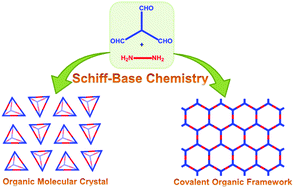In the past decade there has been tremendous interest in the development of organic porous materials due to their great potential in gas storage/separation and catalysis applications. These purely organic-based porous materials are constructed through covalent bonds and usually exhibit high chemical and thermal stability. A variety of chemical reactions have been utilized to construct organic porous materials, among which Schiff-base chemistry has been one of the most frequently used approaches. Since such chemistry doesn't require expensive transition metal catalysts and also has “self-correction” capability under thermodynamic control, it has been widely utilized in materials development. Typically, organic porous materials can be classified into two groups: porous organic molecular cages and porous organic networks. In this article, we highlight the recent progress of utilizing Schiff-base chemistry to construct discrete organic molecular cages as well as porous polymer networks. These studies showed the great structure tunability (e.g., pore size, surface functionality) of purely organic-based porous materials, and the findings would open up many new possibilities for the design and synthesis of novel organic porous materials targeting a variety of important energy and environmental applications.
